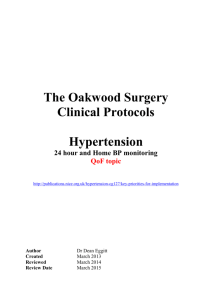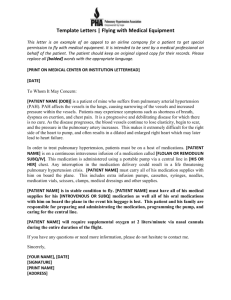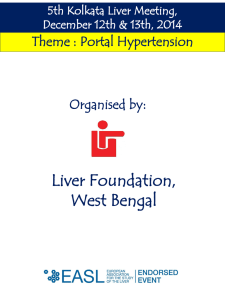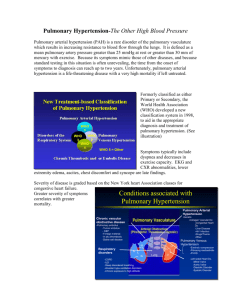study of portopulmonary hypertension in patients with cirrhosis of liver
advertisement
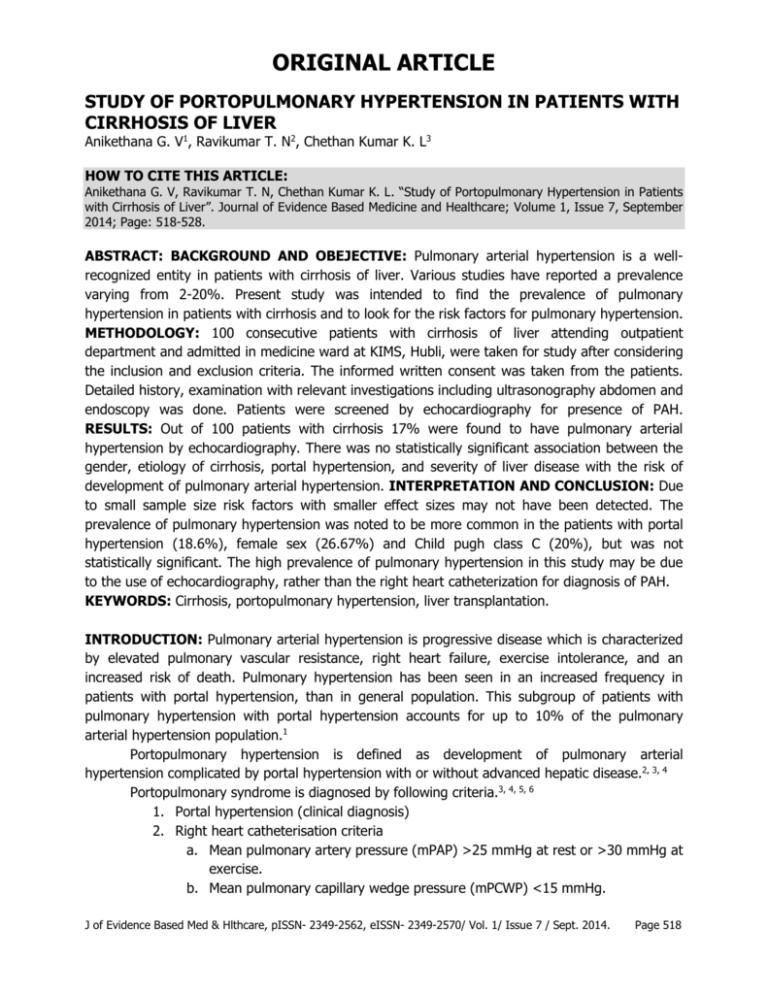
ORIGINAL ARTICLE STUDY OF PORTOPULMONARY HYPERTENSION IN PATIENTS WITH CIRRHOSIS OF LIVER Anikethana G. V1, Ravikumar T. N2, Chethan Kumar K. L3 HOW TO CITE THIS ARTICLE: Anikethana G. V, Ravikumar T. N, Chethan Kumar K. L. “Study of Portopulmonary Hypertension in Patients with Cirrhosis of Liver”. Journal of Evidence Based Medicine and Healthcare; Volume 1, Issue 7, September 2014; Page: 518-528. ABSTRACT: BACKGROUND AND OBEJECTIVE: Pulmonary arterial hypertension is a wellrecognized entity in patients with cirrhosis of liver. Various studies have reported a prevalence varying from 2-20%. Present study was intended to find the prevalence of pulmonary hypertension in patients with cirrhosis and to look for the risk factors for pulmonary hypertension. METHODOLOGY: 100 consecutive patients with cirrhosis of liver attending outpatient department and admitted in medicine ward at KIMS, Hubli, were taken for study after considering the inclusion and exclusion criteria. The informed written consent was taken from the patients. Detailed history, examination with relevant investigations including ultrasonography abdomen and endoscopy was done. Patients were screened by echocardiography for presence of PAH. RESULTS: Out of 100 patients with cirrhosis 17% were found to have pulmonary arterial hypertension by echocardiography. There was no statistically significant association between the gender, etiology of cirrhosis, portal hypertension, and severity of liver disease with the risk of development of pulmonary arterial hypertension. INTERPRETATION AND CONCLUSION: Due to small sample size risk factors with smaller effect sizes may not have been detected. The prevalence of pulmonary hypertension was noted to be more common in the patients with portal hypertension (18.6%), female sex (26.67%) and Child pugh class C (20%), but was not statistically significant. The high prevalence of pulmonary hypertension in this study may be due to the use of echocardiography, rather than the right heart catheterization for diagnosis of PAH. KEYWORDS: Cirrhosis, portopulmonary hypertension, liver transplantation. INTRODUCTION: Pulmonary arterial hypertension is progressive disease which is characterized by elevated pulmonary vascular resistance, right heart failure, exercise intolerance, and an increased risk of death. Pulmonary hypertension has been seen in an increased frequency in patients with portal hypertension, than in general population. This subgroup of patients with pulmonary hypertension with portal hypertension accounts for up to 10% of the pulmonary arterial hypertension population.1 Portopulmonary hypertension is defined as development of pulmonary arterial hypertension complicated by portal hypertension with or without advanced hepatic disease.2, 3, 4 Portopulmonary syndrome is diagnosed by following criteria.3, 4, 5, 6 1. Portal hypertension (clinical diagnosis) 2. Right heart catheterisation criteria a. Mean pulmonary artery pressure (mPAP) >25 mmHg at rest or >30 mmHg at exercise. b. Mean pulmonary capillary wedge pressure (mPCWP) <15 mmHg. J of Evidence Based Med & Hlthcare, pISSN- 2349-2562, eISSN- 2349-2570/ Vol. 1/ Issue 7 / Sept. 2014. Page 518 ORIGINAL ARTICLE c. Pulmonary vascular resistance (PVR) >240 dyne/sec/cm-5. d. Exclude other causes of pulmonary artery hypertension. Portopulmonary hypertension is present in approximately 5% of all liver transplantation candidates.7 Pulmonary hypertension in patients with cirrhosis is usually asymptomatic,2 but carries a poor prognosis. Presence of PPH confers a mortality of 40% at 1 year and 70% at 3 years for isolated liver transplantation.2 Pulmonary hypertension with pressure of more than >50 mmHg is a contraindication for liver transplantation.8 Pulmonary artery pressure of 35-50 mmHg is associated with increased mortality (50%) during liver transplantation and is also a contraindication for liver transplantation,8,9 whereas prognosis and outcomes in patients with pulmonary artery pressure of <35 mmHg is similar to other liver transplantation candidates.4 Screening by echocardiography, has been a standard practice in all patients with cirrhosis undergoing liver transplantation.10 Screening is also performed in patients with cirrhosis with history or examination suggestive of pulmonary hypertension.11 Patients who are detected to have a PASP >50 mmHg on echocardiography are subjected to right heart catheterization before liver transplantation3 and their suitability for liver transplantation is assessed. In a study conducted by Krowka et al, 10.9% of the patients had mPAP of >50 mmHg on echocardiography. They were subjected for right heart catheterization. The false positive result was seen in 35%; the remaining 65% met the criteria for PPH.7 Swanson et al12 showed that patients with PPH who received no therapy had 5 year survival of 14%. Those who received therapy for PAH only had 45% 5 year survival. Those who received liver transplantation with or without treatment for PAH had 5 year survival of 67% and 25% respectively, thus highlights the importance of screening and treatment of PPH. AIMS AND OBJECTIVES: 1. To study the frequency of pulmonary hypertension in patients with cirrhosis of liver 2. To compare the association of pulmonary hypertension in cirrhotic patients, with respect to clinical features, Child-Pugh Class and presence or absence of portal hypertension. MATERIALS AND METHODS: SOURCE OF DATA: Patients with cirrhosis of liver attending to outpatient department and admitted in Medicine wards at Karnataka Institute of Medical Sciences, Hubli between 1st of January 2012 to 31st of December 2012 were taken for study considering the inclusion and exclusion criteria. METHODS OF COLLECTION OF DATA: Cirrhotic patients fulfilling the inclusion and exclusion criteria were informed regarding the aim of study and informed consent was taken. Information was taken through the prepared proforma from each patient. Type of study: Cross-sectional study. J of Evidence Based Med & Hlthcare, pISSN- 2349-2562, eISSN- 2349-2570/ Vol. 1/ Issue 7 / Sept. 2014. Page 519 ORIGINAL ARTICLE Sample size: Total of 100 consecutive cirrhotic patients fulfilling the inclusion and exclusion criteria were included in the study. Inclusion Criteria: Known cases of cirrhosis of liver Age >18 years Willing to give consent for study Exclusion Criteria: Age <18 years Congenital heart diseases Chronic obstructive lung diseases Left ventricular disease Valvular heart disease HIV infected patients Current smokers INVESTIGATIONS: After applying inclusion and exclusion criteria 100 consecutive cirrhotic patients underwent following set of investigations, as relevant: Serum bilirubin Serum albumin PT/INR Platelet count Serum creatinine HBsAg Anti-HCV Antibody to HDV ECG Chest-X-ray 2D-ECHO and Doppler echocardiography USG abdomen Endoscopy PROTOCOL: Patients with cirrhosis were selected as per the criteria laid down. Their written informed consent was taken. The history was elicited with special reference to alcohol consumption, symptoms suggestive of portal hypertension and pulmonary hypertension. Detailed physical examination was carried out. Each subject underwent relevant investigations and the data was noted. Child Pugh and MELD score was calculated for each patient. Diagnosis of portal hypertension was based either on clinical examination, portal vein diameter or doppler flow or based on endoscopic assessment for esophageal varices. USG abdomen was done to look for liver size and architecture, ascites, portal venous system including portal vein diameter, portal vein flow and portosystemic collateral venous J of Evidence Based Med & Hlthcare, pISSN- 2349-2562, eISSN- 2349-2570/ Vol. 1/ Issue 7 / Sept. 2014. Page 520 ORIGINAL ARTICLE communications. Portal vein diameter was assessed at the confluence of portal vein with inferior vena cava in supine position. If the diameter was >13mm it is indicative of portal hypertension with sensitivity of 45-50% and specificity of 100%.13 Pulmonary hypertension was determined by using Doppler echocardiography. Difference in the pressure between the right atrium and ventricle in systole (P1-P2) was assessed by noting the peak velocity of the tricuspid regurgitant jet, using color mapping and applying Bernoulli equation. The right ventricular systolic pressure (RVSP) is equal to four times the square of peak velocity of tricuspid jet (V) plus right atrial pressure (Pra), RVSP = 4V2 + Pra In the absence of obstruction to the right ventricular output, the pulmonary systolic artery pressure (PASP) is equal to the right ventricular systolic pressure. A value of >40 mmHg at rest was taken to be suggestive of pulmonary artery hypertension.14 STATISTICAL ANALYSIS: The continuous variable such as age was expressed in terms of average ± standard deviation. The statistical significance of an observation was determined by calculation of p value using chi-square test or Fisher’s exact test as relevant. A p value of <0.05 was taken as statistically significant. RESULTS: A total of 123 patients were screened for eligibility to the study. 6 patients didn’t provide consent for the study and 17 patients met the exclusion criteria. 100 consecutive patients with cirrhosis meeting the inclusion and exclusion criteria attending the outpatient department and admitted to the medical wards at KIMS, Hubli were included in the present study. Age group 21-30 31-40 41-50 51-60 >60 Total Female 0 5 6 4 0 15 Male 7 31 31 14 2 85 Total 7 36 37 18 2 100 Table 1: Distribution of cases according to age and gender As shown in the table above men between the ages of 31-40 years and 41-50 years are predominantly affected, accounting for 62% of the cases. Overall mean age is 42.46 ± 8.64 years. The mean age for men and women is 41.93±8.87 years and 45.47±6.64 years respectively. J of Evidence Based Med & Hlthcare, pISSN- 2349-2562, eISSN- 2349-2570/ Vol. 1/ Issue 7 / Sept. 2014. Page 521 ORIGINAL ARTICLE Portal hypertension Total Present (%) Absent (%) A 1 (16.67) 5 (83.33) 6 B 38 (86.36) 6 (13.64) 44 C 47 (94.00) 3 (6.00) 50 Total 86 (86.00) 14 (14.00) 100 Table 2: Distribution of cases according to Child-Pugh class and presence or absence of portal hypertension Child-Pugh class Majority of the patients in Child Pugh class B (86.36%) and Child Pugh class C (94%) had portal hypertension, as against to only 16.67% of patients in Child Pugh class A. The increasing severity of liver disease as assessed by Child Pugh class was associated with increased incidence of portal hypertension (p value <0.0001). MELD score Portal hypertension Total Absent (%) Present (%) <9 10-19 4 (40) 7 (9.86) 6 (60) 64 (90.14) 10 71 20-29 3 (15.79) 16 (84.21) 19 30-39 0 0 0 >40 0 0 0 Total 14 86 100 Table 3: Distribution of cases according to MELD score and presence or absence of portal hypertension Portal hypertension was present in 60% of the cases with MELD score <9, as against 90.14% in patients with MELD score between 10 and 19. There was statistical significance between the MELD score and presence of portal hypertension (p value is 0.0354). Pulmonary hypertension Frequency Percentage Present 17 17 Absent 83 83 Total 100 100 Table 4: Distribution of cases by presence or absence of pulmonary hypertension Pulmonary hypertension was present in 17 of the 100 patients with cirrhosis. Dyspnea on exertion (DOE) is present in 4 (23.53%) out of 17 patients with pulmonary hypertension and 6 (7.23%) out of 83 patients without pulmonary hypertension. DOE has J of Evidence Based Med & Hlthcare, pISSN- 2349-2562, eISSN- 2349-2570/ Vol. 1/ Issue 7 / Sept. 2014. Page 522 ORIGINAL ARTICLE sensitivity, specificity, positive predictive value and negative predictive value for suspecting pulmonary hypertension in cirrhotic patients is 23.53%, 92.77%, 40% and 85.56% respectively. The other causes of DOE were tense ascites (4; 40%) and hepatic hydrothorax (2; 20%). Parasternal heave was present in only one of the 17 patients with pulmonary hypertension and none of the patients without pulmonary hypertension. The sensitivity, specificity, positive predictive value and negative predictive value for parasternal heave for detection of pulmonary hypertension in cirrhotic patients is 5.88%, 100%, 100% and 83.84% respectively. Loud pulmonic component of second heart sound was found in 6 (35.29%) of the 17 patients with pulmonary hypertension and 3 (3.61%) of the 83 patients without pulmonary hypertension. The sensitivity, specificity, positive predictive value and negative predictive value for loud P2 to detect pulmonary hypertension in cirrhotic patients is 35.29%, 96.39%, 66.67% and 87.91% respectively. Tricuspid regurgitation was found in none of the patients with or without pulmonary hypertension. Pulmonary hypertension Total Present Absent Male 13 72 85 Female 4 11 15 Total 17 83 100 Table 5: Distribution of cases by gender and presence or absence of pulmonary hypertension Gender Above table shows the distribution of pulmonary hypertension based on the gender, 26.67% of women with cirrhosis and 15.92% of men with cirrhosis have developed pulmonary hypertension. The female gender was not associated with increased risk of developing pulmonary hypertension (p value is 0.4788). The average age of patients with pulmonary hypertension was 45.18±8.47 years, as against 41.9±8.62 years for those without pulmonary hypertension. Age does not influence the risk of development of pulmonary hypertension in patients with cirrhosis of liver (p value is 0.6826). Pulmonary hypertension Total Present Absent Alcohol 14 68 82 HBV 1 7 8 HCV 1 2 3 Others 1 6 7 Total 17 83 100 Table 6: Distribution of cases based on cause of cirrhosis and presence or absence of pulmonary hypertension Cause of cirrhosis J of Evidence Based Med & Hlthcare, pISSN- 2349-2562, eISSN- 2349-2570/ Vol. 1/ Issue 7 / Sept. 2014. Page 523 ORIGINAL ARTICLE Among the 82 patients with alcoholic cirrhosis, 14 (17.07%) patients had pulmonary hypertension. Of the 18 patients with non-alcoholic cirrhosis 3 (16.67%) had pulmonary hypertension. Alcoholic cirrhosis is not associated with increased risk of pulmonary hypertension in comparison to non-alcoholic cirrhosis cases (p value equals 0.9668). Pulmonary hypertension Total Present Absent Present 16 70 86 Absent 1 13 14 Total 17 83 100 Table 7: Distribution of cases based on presence or absence of portal and pulmonary hypertension Portal hypertension All except one patient with pulmonary hypertension had evidence of portal hypertension. The presence of portal hypertension cirrhotic patients had a sensitivity, specificity, positive predictive value and negative predictive value of 94.12%, 15.66%, 18.60% and 92.86% respectively, for predicting pulmonary hypertension. The prevalence of pulmonary hypertension in cirrhotic patients with portal hypertension was 18.6%, as against 7.14% for those without portal hypertension. The association between portal hypertension and pulmonary hypertension was not statistically significant (p value is 0.4535). Only one of the patient with MELD score <9 had evidence of pulmonary hypertension, whereas 18.3% and 15.79% of patients with MELD score between 10 to 19 and 20 to 29 had pulmonary hypertension respectively. 13 of the 17 patients with pulmonary hypertension had a MELD score between 10 and 19, accounting for 76.47% of patients with pulmonary hypertension. The relationship between MELD score and pulmonary hypertension was not statistically significant (p value is 0.7985). Pulmonary hypertension Total Present Absent Present 1 0 1 1 A Absent 5 0 5 5 Present 38 7 31 38 B Absent 6 0 6 6 Present 47 9 38 47 C Absent 3 1 2 3 Total 100 17 83 100 Table 8: Distribution of cases according to Child Pugh class and presence or absence of portal and pulmonary hypertension Child Pugh class Portal hypertension The above table shows the relationships between the severity of liver disease, as assessed by Child Pugh class, and portal hypertension and pulmonary hypertension. Severity of liver J of Evidence Based Med & Hlthcare, pISSN- 2349-2562, eISSN- 2349-2570/ Vol. 1/ Issue 7 / Sept. 2014. Page 524 ORIGINAL ARTICLE disease had statistically significant association with development of portal hypertension (p value is <0.0001). Severity of liver disease (p value is 0.4538) or portal hypertension (p value is 0.4535) had no statistically significant association with development of pulmonary hypertension. DISCUSSION: The association between the cirrhosis of liver and pulmonary arterial hypertension has been noted since 1951, when Mantz and Craige15 described a woman with portal vein thrombosis and plexogenic pulmonary arteriopathy. Various studies7, 16, 17, 18 in patients with cirrhosis of liver have found a prevalence of pulmonary arterial hypertension between 2 to 20%. Pulmonary hypertension in patients with cirrhosis of liver accounts for about 10% of all cases of pulmonary arterial hypertension.1 In our study of 100 patients with cirrhosis of liver, 17 patients had pulmonary arterial hypertension. References Castro M et al19 Ghayumi SMA et al20 Auletta M et al17 Pilatis ND et al21 Study population 362 patients undergoing liver transplantation 99 patients with cirrhosis 83 patients with cirrhosis 55 patients who had undergone OLT (retrospective study) Hadenque A et al16 507 patients with portal hypertension Colle IO et al22 165 patients before liver transplantation Carolyn DL et al23 190 patients before liver transplantation 1235 patients who underwent liver transplantation 100 patients with cirrhosis of liver Krowka MJ et al7 Our study Diagnostic test Right heart catheterization Echocardiography Echocardiography Right heart catheterization Right heart catheterization Right heart catheterization Echocardiography Right heart catheterization Echocardiography Result 4% 6.1% 20% 14.55% 2% 6.06% 12% 5.34% 17% Table 9: Different studies estimating the prevalence of PAH in cirrhosis of liver The wide range of variation seen in the different studies is due to the different criteria and test used for diagnosis of pulmonary arterial hypertension. Methods using PASP measured by echocardiograph including our study tend to overestimate the prevalence of PAH. In our study age had no statistically significant influence on the development of pulmonary hypertension (p value is 0.6826). This is in agreement with the findings of the studies conducted by Castro M et al,19 Kawut SM et al,24 Pilatis et al,21 and Kuo PC et al.18 In our study prevalence was more in the female patients with cirrhosis, but this didn’t reach statistical significance (p value is 0.4788). This is consistent with the study conducted by Castro M et al.19 Contrary to our study, study conducted by Kawut SM et al24 (p value 0.018) found that pulmonary hypertension is encountered more frequently in females, than males. This difference may be due to the smaller sample size of female patients in our study (15%). J of Evidence Based Med & Hlthcare, pISSN- 2349-2562, eISSN- 2349-2570/ Vol. 1/ Issue 7 / Sept. 2014. Page 525 ORIGINAL ARTICLE References Castro M et al 19 Risk of PAH (based on etiology) P value None >0.05 Ghayumi SMA et al20 Cryptogenic cirrhosis associated with increased risk Kawut SM et al24 Autoimmune hepatitis associated with increased risk 21 Pilatis ND et al None Kuo PC et al18 None Our study None 0.04 0.031 >0.05 >0.05 0.9668 Table 10: Risk of development of PAH based on etiology of cirrhosis In our study, 10 patients had history of dyspnea on exertion. Of the ten patients 4 had pulmonary artery hypertension, 4 had tense ascites and 2 had hepatic hydrothorax. 13 (76.47%) of 17 patients with pulmonary hypertension had no symptom suggestive of pulmonary artery hypertension. Hadenque A et al16 found that more than half of the patients (60%) with PAH had no symptoms of pulmonary arterial hypertension, which is consistent with our study. Variable References Patients with PAH Patients without PAH Our study 1 (5.88%) 0 Parasternal heave 21 Pilatis ND et al 3 (38%) 2 (4%) Our study 6 (35.29%) 3 (3.61%) Loud P2 21 Pilatis ND et al 3 (38%) 1 (2%) Tricuspid regurgitation Our study 0 0 Table 11: Physical examination findings of PAH in patients with cirrhosis The sensitivity of parasternal heave and loud P2 for predicting PAH in our study was 5.88% and 35.29% respectively. Hence they are unreliable for screening for pulmonary hypertension. The presence of portal hypertension and portosystemic shunts are thought to be the single most important factors determining the risk of development of pulmonary hypertension in patients with cirrhosis of liver. Of the 86 patients in our study 16 had pulmonary hypertension (18.6%). The strength of association was not statistically significant (p value is 0.4535). This is in accordance with the studies of Castro M et al19, Pilatis ND et al21 and Hadenque A et al.16 The presence of portal hypertension in patients with cirrhosis has a sensitivity and negative predictive value of 94.12% and 92.86% for predicting pulmonary hypertension. In our study of 100 patients, none of the patients in Child Pugh class A had pulmonary hypertension, 15.9% and 20% of the patients in Child Pugh class B and C respectively, had pulmonary hypertension. This was not statistically significant (p value is 0.4538). This is in agreement with the studies conducted by Castro M et al,19 Ghayumi SMA et al,20 Kawut SM et al24 and others. Auletta M et al17 found increased risk of pulmonary hypertension with increasing severity of liver disease. This however has not been reproduced in other studies. J of Evidence Based Med & Hlthcare, pISSN- 2349-2562, eISSN- 2349-2570/ Vol. 1/ Issue 7 / Sept. 2014. Page 526 ORIGINAL ARTICLE CONCLUSION: The present study explored the prevalence of pulmonary arterial hypertension in patients with cirrhosis and risk factors for development of pulmonary arterial hypertension. Gender, etiology of cirrhosis, portal hypertension and severity of liver disease had no statistically significant impact on risk of development of pulmonary arterial hypertension. The significance of determining PAH in patients with cirrhosis who are not undergoing liver transplantation is not yet clear, due to lack of effective and safe therapies available for the same. All the patients undergoing liver transplantation should undergo screening for PAH by echocardiography and evaluated and managed accordingly. Further studies are needed to know the natural history of asymptomatic PAH, efficacy of treatment and effect of treatment on mortality and morbidity in cirrhotic patients who are not undergoing liver transplantation. BIBLIOGRAPHY: 1. Pavec J, Souza R, Herve P et al. Portopulmonary hypertension: survival and prognostic factors. Am J respire Crit Care Med 2008; 178(6): 637-643. 2. Tam NL, He XS. Clinical management of portopulmonary hypertension. HeaptobiliaryPancreatDis Int 2007; 6: 464-469. 3. Krowka MJ. Management of pulmonary complications in pretransplant patients. Clin Liver Dis 2011; 15: 765-777. 4. Saleemi S. Portopulmonary hypertension. Ann Thorac Med 2010; 5(1): 5-9. 5. Hoeper MM, Krowka MJ, Strassburg CP. Portopulmonary hypertension and hepatopulmonary syndrome. Lancet 2004; 363: 1461-1468. 6. Rodroguez-Roisin R, Krowka MJ. Hepatopulmonary syndrome: a liver induced lung disorder. N Engl J Med 2008; 358: 2378-2387. 7. Krowka MJ, Swanson KL, Frantz RP et al. Portopulmonary hypertension: results from a 10year screening algorithm. Hepatology 2006; 44: 1502-1510. 8. Ahmed A, Keeffe EB. Current indications and contraindications for liver transplantation. Clin Liver Dis 2007; 11(2): 227-247. 9. Krowka MJ, Plevak DJ, Findlay JY et al. Pulmonary hemodynamics and periopertaive cardiopulmonary-related mortality in patients with portopulmonary hypertension undergoing liver transplantation. Liver Transpl 2000; 6: 443-450. 10. Murray KF, Carithers RJ Jr. AASLD practice guidelines: evaluation of the patient for liver transplantation. Hepatology 2005; 41: 1407-1432. 11. Rich S. Primary pulmonary hypertension: executive summary from the world symposium. WHO Programme on Cardiovascular Diseases, 1998. Available at: http: //www.who.int/ned/evd/pph.html (Accessed on October 15, 2013). 12. Swanson KL, Wiesner RH, Nyberg SL et al. Survival in porto pulmonary hypertension: Mayo Clinic experience categorized by treatment subgroups. Am J Transplant 2008; 8: 2445-2453. 13. Cokkins DD, Dourakis SP. Ultrasonographic assessment of cirrhosis and portal hypertension. Curr Med Img Rev 2009: 5: 62-70. J of Evidence Based Med & Hlthcare, pISSN- 2349-2562, eISSN- 2349-2570/ Vol. 1/ Issue 7 / Sept. 2014. Page 527 ORIGINAL ARTICLE 14. The Task Force on Diagnosis and Treatment of Pulmonary Arterial Hypertension of the European Society of Cardiology. Guidelines on diagnosis and treatment of pulmonary arterial hypertension. Eur Heart J 2004; 25: 2243-2278. 15. Mantz FA Jr, Craige E, Groszmann RJ. Portal axis thrombosis with spontaneous portacaval shunt and resultant corpulmonale. Arch Pathol 1951; 52: 91-97. 16. Hadenque A, Benhayoun MK, Lebrec D, Benhamou JP. Pulmonary hypertension complicating portal hypertension: prevalence and relation to splanchnic hemodynamics. Gastoenterology 1991; 100: 520-528. 17. Auletta M, Oliviero U, Iasiuolo L, Scherillo G, Antoniello S. Pulmonary hypertension associated with liver cirrhosis: An echocardiographic study. Angiology 2000; 51: 1013-1020. 18. Kuo PC, Plotkin JS, Johnson LB et al. Distinctive clinical features of portopulmonary hypertension. Chest 1997; 112: 980-986. 19. Castro M, Krowka MJ, Schroeder et al. Frequency and clinical implications of increased pulmonary artery pressures in liver transplant patients. Mayo ClinProc 1996; 71(6): 543551. 20. Ghayumi SMA, Mehrabi S, Zamirian M et al. Pulmonary complications in cirrhotic candidates for liver transplantation. Hepat Mon 2010; 10(2): 105-109. 21. Pilatis ND, Jacobs JE, Rerkpattanapipat P et al. Clinical predictors of pulmonary hypertension in patients undergoing liver transplant evaluation. Liver Transpl 2000; 6(1): 85-91. 22. Colle IO, Moreau R, Godinho E et al. Diagnosis of portopulmonary hypertension in candidates for liver transplantation: a prospective study. Hepatology 2003; 37: 401-409. 23. Donovan C, Marcovitz P, Punch J et al. Two-dimensional echocardiography and dobutamine stress echocardiography in the preoperative assessment of the patients with end-stage liver disease prior to orthotopic liver transplantation. Transplantation 1996; 61: 1180-1188. 24. Kawut SM, Krowka MJ, Trotter JF et al. Clinical risk factors for portopulmonary hypertension. Hepatology 2008; 48: 196-203. AUTHORS: 1. Anikethana G. V. 2. Ravikumar T. N. 3. Chethan Kumar K. L. PARTICULARS OF CONTRIBUTORS: 1. Post Graduate Student, Department of General Medicine, Karnataka Institute of Medical Sciences, Hubli. 2. Post Graduate Student, Department of General Medicine, Karnataka Institute of Medical Sciences, Hubli. 3. Post Graduate Student, Department of General Medicine, Karnataka Institute of Medical Sciences, Hubli. NAME ADDRESS EMAIL ID OF THE CORRESPONDING AUTHOR: Dr. Anikethana G. V, #d1-278, 5th Cross, 3rd Main, Leelavathi Extension, Maddur, Mandya District, Karnataka – 571428. E-mail: anikethana.g.v@gmail.com Date Date Date Date of of of of Submission: 11/08/2014. Peer Review: 12/08/2014. Acceptance: 16/08/2014. Publishing: 02/09/2014. J of Evidence Based Med & Hlthcare, pISSN- 2349-2562, eISSN- 2349-2570/ Vol. 1/ Issue 7 / Sept. 2014. Page 528



